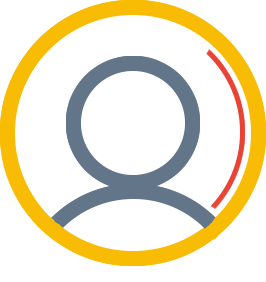 |
Enterprise Application User |
- Creates Transactions and Updates Record Entries (e.g., Marketing Campaign, Sales Order, Purchase Order, Work Order, Warehouse Stock Location, Shipment, Bill and more). Uses transaction application screens and reporting and goes to EDW analytics when needed.
- Can work in one process area or across enterprise areas. Enterprise-wide users are concerned with the overall process. Analytics assist with Enterprise Processes like Campaign-to-Cash.
- Users need to relate Software Application data (data in screens or fields) to Analytic metadata. For example, Sales Order No. or PO Line Item Dollar Amount. Downstream metadata is created with new columns (includes computations).
|
 |
Enterprise Application Lead |
- Enterprise Application or Local Application Lead with data included or planned to be included in the EDW. Understands application screens, data, in-system reporting, data exports, connected systems and related EDW analytics. Skilled with business and technical aspects.
- Supports the business and responsible for application data, system configuration, user access and system performance.
- Can hold Master Data (keeping up-to-date, business needs), Dimensions and/or Facts for the EDW.
- May use local application or external data for compute (includes data science and hyperscale) and storage.
- Key person for coordination and extracts from the application, related data sources and metadata. May have a local Data Dictionary.
|
 |
COTS and In-house Application User |
- Local Commercial off-the-shelf (COTS) and In-house Custom Built Applications can be critical to Operations, Strategic and Business Processes. And it can be a mix of both COTS and In-house software and hardware integrated modules working together to provide a process solution. Many In-house Applications are in Manufacturing and Logistics areas. They can be MS Access, MS Excel, .NET, SQL Server and others. Do you replace In-house Solutions if they are working?
- Better to understand the In-house solutions and seek alternative solutions if you want to migrate to a better solution (identify alternatives). These applications hold key metadata and can be included in a Data Dictionary.
|
 |
COTS and In-house Application Lead |
- Many times the builder of the application solution is the key contact. Good documentation and metadata is important. If it's an older solution (original builder leaves) it poses risk if not completely understood. These solutions require a different level of detailed documentation.
|
 |
Business Analyst |
- While shown in the "Enterprise Data Landscape" diagram as working in the beginning and end of the overall process, they can analyze any area around enterprise applications and data preparation for improvements. Continuous improvement. Company objectives focused. Aware of Data Science and its use in core enterprise applications and analytics.
- Problems to be solved. Process focused. Can prototype internal and external data for leadership, sales, supply, operations and more.
- Can work in one "process" area or across areas. Enterprise-wide Analytics assists these users (exports as well). Also, trains users with data in screens relative to analytic metadata use. They also may use raw data from multiple sources when structuring solutions (their work fosters Enterprise Application use and EDW improvements).
|
 |
Data Lake Architect |
- Can analyze, structure and lead single or overall Data Lake efforts.
- Good with ingesting and storing large data sets and reducing size for downstream use. Skilled with ETL and ELT. Application, Market, Industry, Machine, Sensor, Social Data and more.
- Designs overall Data Science efforts in the Data Lake.
|
 |
Data Scientist |
- Data Scientist Skills, ETL and ELT.
- Can analyze, structure and use Data Science methods and techniques on their desktop, Data Lake and EDW.
- Good with external data sources and computations (R, Python, Java, Scala, Packages, SQL and Big Data tools). Can Hyperscale very large processing jobs.
|
 |
ETL Developer |
- Works on Data Sources and required EDW data structure. Data experts and knows the enterprise database schema.
- Considers all aspects and the focus is loading data to the EDW correctly. SQL experts.
|
 |
EDW Architect |
- Considers all aspects for the EDW and super skilled in business and technical aspects. Understands and refines the overall EDW data model(s) or Enterprise Database Schema.
- Coordinates the entire data landscape from source to end use.
- Typically years of enterprise data experience and highly-skilled with data modeling, large database schemas, transforms, data loading and SQL. Provides enterprise compact data (strategic and actionable details).
|
 |
EDW Developer |
- Works on Data Sources and needed "Structured Data." They also work with ETL Developers closely and have the goal of producing Structured Tables for the Enterprise Analytics Server Architect and ensuring EDW data loads meet agreed Service-level agreements (SLAs). Key role in the overall process for Data Management and multidimensional structures. Super skilled with SQL.
- Considers all aspects and the focus is the Enterprise Database Schema.
|
 |
Enterprise Analytics Server Architect |
- Works on overall analytics server adoption and use to standardize metadata and access for users. Concerned with user access, metadata, data accuracy, analysis capability, EDW refresh speeds and data load statuses.
- Concerned with providing easy-to-use objects (metadata) for ad hoc users (business schema use), visualizations, standard reports, adding or removing EDW Tables/Columns. Strongly considers downstream impacts. Also works with Administrators for security purposes.
- Can be thousands of users from all areas of the business and hundreds or thousands of visualizations and reports (some with non-Analytics Server metadata; user and analytic developer built).
|
 |
Analytics Developer (IT) |
- Creates visualizations and reports and refine other user builds for standardization. Typically coordinates with the Analytics Superuser to standardize visualizations and reports.
- Key development role in large analytic systems. Goal is to remove low-level queries and reduce query time and/or increase analysis capability. May require backend EDW changes. Can work with Analytics Superusers and Analytic Users directly. Super skilled with SQL and format presentation. Work is usually tested and approved by the Analytics Superuser and/or the Analytic Users.
|
 |
Analytics Superuser (Business) |
- Subject matter expert in one or more process areas and knows available visualizations and reports. Key role in large analytic systems. Assists with access requests. May export data.
- Works with the Analytics Developer (IT) and Analytic Users (many). May create visualizations and reports and refine other user builds for standardization and testing or validation.
|
 |
Analytics User |
- Can use standard company visualizations and reports for one process area or more (e.g., Sales Orders or multiple areas for coordination). May export data.
- Works with Analytics Superuser to change or request new visualizations or reports. Provides insight for daily work needs.
- The Analytics User is the Customer for Metadata, Data and Analytics. Requires metadata reference, data accuracy, analysis abilities, adequate refresh speeds, correct formats and ease-of-use.
|